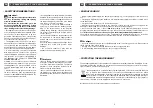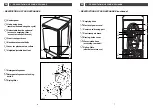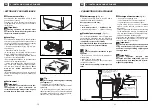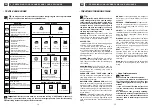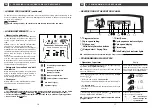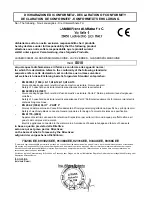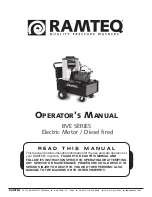
• TEXTILE CARE CODES
13
EN
12
EN
3 / PREPARING YOUR LAUNDRY AND YOUR APPLIANCE
3 / PREPARING YOUR LAUNDRY AND YOUR APPLIANCE
Tip :
To help you care for your textiles, they have a label giving the necessary information.
They are expressed in codes by the symbols below:
Important :
Before the first wash, we recommend running a "COTTON 90° without pre-
wash" cycle without load, using 1/2 the usual detergent quantity. This will eliminate any
manufacturing residue that may be left in the machine.
• TREATING STUBBORN STAINS
Tip :
Perspiration, blood, fruit, wine and cho-
colate stains generally come out with biologi-
cal detergents, but other stains require speci-
fic treatment before machine washing. First
conduct a test on an inconspicuous part of
the textile and rinse thoroughly. If you use a
stain remover, always start on the outside of
the stain to prevent ring marks.
CANDLE WAX:
remove the excess of the stain
by scraping. Then place absorbent paper on
either side of the fabric and run a warm iron
over the stain to melt the remaining wax.
COFFEE - TEA:
- on white cotton: blot the stain using hydrogen
peroxide* before normal washing
- on coloured cotton: blot the stain using a
vinegar/water solution (2 tbsp white vinegar
for 1/4 litre of water) before normal washing
- on wool: blot the stain using a combination of
equal parts alcohol* and white vinegar before
washing the item.
SLUDGE - TAR:
use Eau Écarlate* stain remo-
ver or otherwise, spread a little butter on the
stain, leave to penetrate then blot with turpen-
tine* spirits.
CHEWING-GUM:
chill it using an ice cube. As
soon as it is hard enough, scratch it with your
nail. Remove the remaining ring using a
degreasing agent*.
CHOCOLATE - FRUIT - FRUIT JUICE - WINE:
blot the stain using a vinegar/water solution (2
tbsp white vinegar for 1/4 litre of water). Rinse
well and wash normally.
BALLPOINT PEN - MARKER PEN:
remove as
much ink as possible by blotting the stain with
absorbent paper. Place a clean cloth behind
the stain and blot the stain using another cloth
soaked in white vinegar for synthetic and artifi-
cial fibres or 90* alcohol for other fibres (if the
textile allows).
GREASE:
immediately sprinkle the fabric with
talc. Leave to dry and brush gently to remove
the talc. Then blot using a degreasing agent
such as mineral spirits*. Rinse and wash nor-
mally.
GRASS:
blot the stain using white vinegar or
90* alcohol (if the textile allows) then rinse
and wash.
KETCHUP - TOMATO SAUCE:
prepare a solu-
tion with one part glycerine for one part hot
water. Let the item soak for an hour, then
wash normally.
PAINT:
do not let paint spots dry. Treat them
immediately with the solvent indicated on the
paint pot (water, turpentine*, white spirit*).
Soap then rinse.
MAKE-UP:
place the stained side of the fabric
on absorbent paper, then dampen the other
side of the fabric with 90* alcohol if the item
allows and if the stain is not greasy.
Otherwise, use a degreasing agent (such as
trichloroethylene*).
RUST:
for slight stains, cover with salt,
squeeze lemon juice on the salt and leave
overnight; then rinse thoroughly and wash.
For heavier stains, use a rust removal product
and follow the manufacturer's instructions
carefully.
BLOOD:
soak the stained item as promptly as
possible in cold salty water, then wash nor-
mally.
•Use of stain removers
Important :
To avoid risk of fire and explosion:
(*) if you use the products recommended in
the recipes above, take care to rinse your
laundry thoroughly before placing it in your
machine
- if you use commercial stain removers, fol-
low the manufacturer's recommendations
carefully.
We remind you that, generally speaking,
stains that are treated promptly are easier to
remove. However, old stains that have been
ironed or dried in tumble dryers cannot be
removed.
50
60
60
40
30
40
40
- Normal mechanical action
- Normal rinse
- Normal spin
USE OF BLEACH
- Reduced mechanical action
- Rinse at decreasing temperature
- Reduced spin
- Reduced mechanical action
- Rinse at decreasing temperature
- Reduced spin
- Reduced mechanical action
- Rinse at decreasing temperature
- Reduced spin
Hand wash only
Maximum temperature
: 40°C
(Some appliances are now equipped with a
program that lets you machine wash this type
of textile)
Bleach permitted: diluted and cold
200 °C
High setting
150 °C
Medium setting
110 °C
Low setting
All usual solvents Tetrachloroethylene
mineral spirits
- Reduced mechanical action
- Reduced drying temperature
- No addition of water (Self-service clea-
ning impossible)
Mineral spirits and
F113 fluorinated
solvent
High tumble dry
Low tumble dry
No wash
Do not tumble dry
No dry clean,
no stain remover
with solvents
No iron
(no steam)
No bleach
- Reduced mechanical action
- Rinse at decreasing temperature
- Reduced spin
- Normal mechanical action
- Normal rinse
- Normal spin
- Normal mechanical action
- Normal rinse
- Normal spin
-- Greatly reduced mechanical action
- Normal rinse
- Normal spin
- Greatly reduced mechanical action
- Normal rinse
- Normal spin
WASHING
IRON
DRY CLEAN
DRYING IN TUMBLE DRYER
Maximum temperature : 95°C
Maximum temperature : 60 or 50°C
Maximum temperature : 40°C
Maximum temperature : 30°C
Normal process
95
95
cl
P
F
A
P
F
Содержание WTD 63111
Страница 1: ...EN Instructions for Use RU Washer Dryer...
Страница 34: ...67 Z Y RU 66 Z Y RU...
Страница 35: ...WTD 63111 WTD 63131 TW2G00259_01 1 3 01 12...



